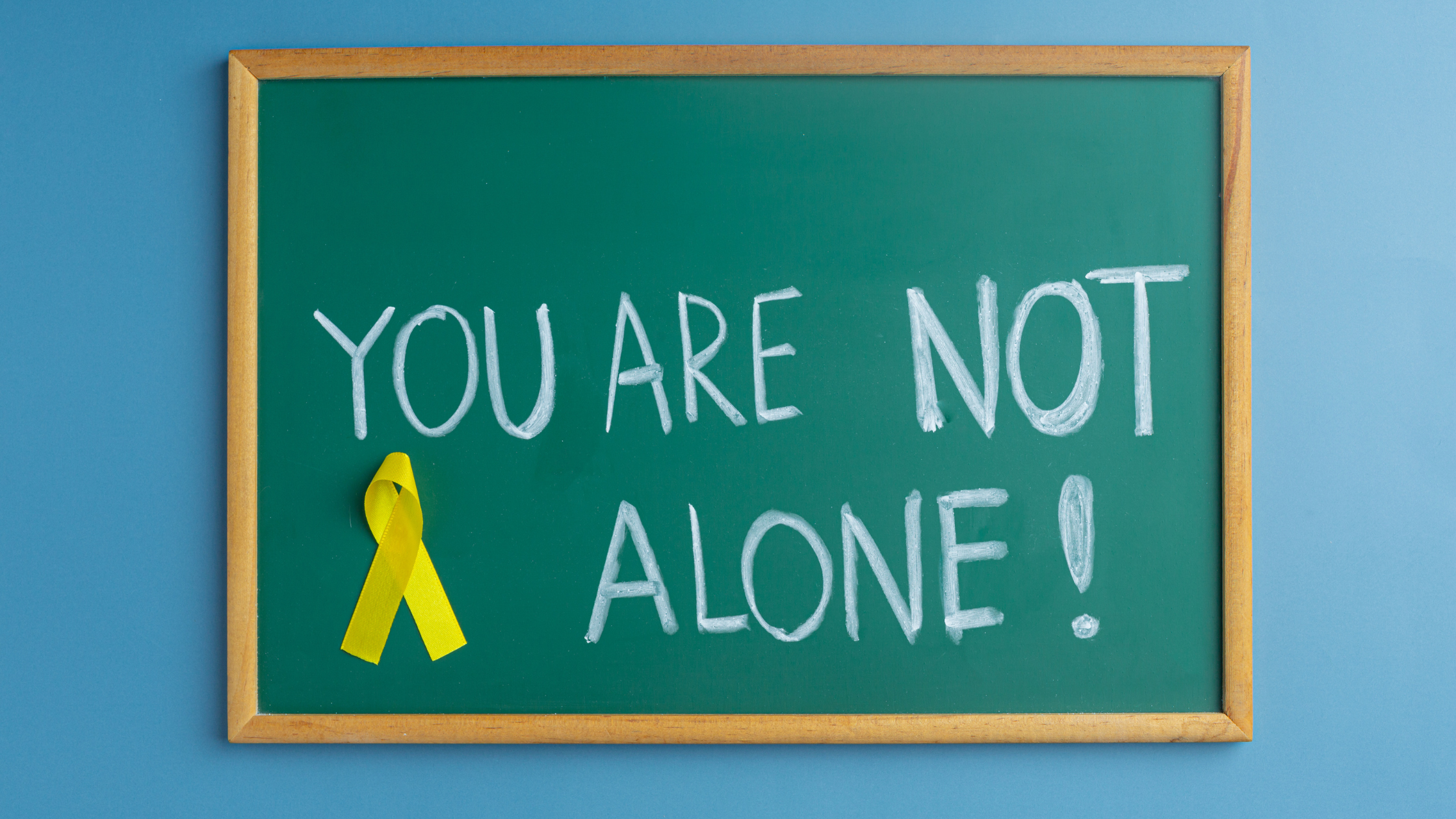On average, there are 130 suicides per day in the U.S.[1] What most people don’t realize is that this tragic loss of life is preventable. That’s why September has been named Suicide Prevention Awareness Month.
This month is a time to share vital information about suicide, shift public perception about an often misunderstood topic, highlight prevention resources, and spread hope.
In light of this, we’ve compiled some information about this far-reaching public health problem and resources for those who may be struggling.
How Common Is Suicide?
Suicide means purposely ending your own life. It affects people of all ages, genders, ethnicities, and backgrounds. In 2020, suicide was among the top nine leading causes of death for people ages 10-64 in the U.S., claiming the lives of 45,979 Americans.[2] That equates to about one death from suicide every 11 minutes. It was also the second leading cause of death for people ages 10-14 and 25-34 in 2020.[2]
The number of people who contemplate or attempt suicide is even higher. In 2020, approximately 12.2 million Americans seriously considered suicide, 3.2 million planned a suicide attempt, and 1.2 million attempted suicide.[2]
Common Myths About Suicide—Debunked
Suicide is a topic that’s surrounded by falsehoods and stigma, both of which can prevent people from getting the help they need to recover. A major goal of suicide prevention is to dispel these myths and educate the public with accurate information.
With that in mind, let’s debunk some of the most common myths about suicide:
Myth #1: Suicide only affects those with mental health conditions
Many people incorrectly believe that only people with a mental illness like depression, anxiety, or bipolar disorder would commit suicide. In reality, many people with mental illness don’t experience suicidal thoughts, and not all individuals who attempt suicide or die by suicide have a mental illness.
In fact, studies have shown that around 54 percent of people who have died by suicide didn’t have a diagnosable mental health disorder.[3]
Common life stressors, such as relationship problems, legal matters, loneliness, the death of a loved one, or a devastating or debilitating illness, are also associated with suicidal thoughts and attempts.[4]
Myth #2: Once a person is suicidal, they will always remain suicidal
Suicide is often an attempt to eliminate deep, painful emotions and thoughts. What many people don’t realize, especially in the moment, is that suicidal thoughts and difficult emotions will eventually pass, just like other thoughts.
While suicidal thoughts can return, they’re never permanent, and treatment is available that can reduce suicidal thoughts and behaviors. Treatment typically involves some combination of psychotherapy, lifestyle changes, family support and education, and medication, such as antidepressants or anti-anxiety medications.[5]
Individuals who have experienced suicidal thoughts and attempts can recover and live long, successful lives.
Myth #3: Most suicides happen without warning
Warning signs typically precede suicide, however, many people are not aware of these signs or the seriousness of them, which might make a suicide seem sudden. Warning signs can also be subtle and don’t always look like “feeling sad.”
Therefore, it’s important to be aware of the wide range of warning signs associated with suicide so you can recognize them in yourself or others.
Warning signs may appear in conversations, through actions, or in social media posts and may include (but are not limited to):[6]
- Talking about feeling hopeless, trapped, or alone
- Sleeping or eating too much or too little
- Social withdrawal from friends, family, and community
- Increased alcohol or drug use
- Aggressive behavior
- Impulsive or reckless behavior
- Dramatic mood swings
- Making a will or giving away personal possessions
- Seeking methods of self-harm, such as searching online or obtaining a gun
- Talking or writing about death
- Talking about suicide as a way out
If you recognize one or more of these signs in yourself or someone close to you, especially if the behavior is new, speak up and take action. You could save a life.
Myth #4: People who die by suicide are selfish, weak, or have a character flaw
Suicide is not a personal failure, but rather a human response to difficult environmental factors and intense emotional pain.
Typically, people don’t die by suicide because they don’t want to live—they take their life to escape their pain. They’re not being “selfish” or “trying to take the easy way out.” Rather, they’re experiencing a very serious mental health symptom.
Maybe they’re struggling with a mental illness. Or perhaps they’ve recently experienced a major life stressor and don’t have healthy coping skills or a strong support system. Regardless, these individuals need compassion and understanding, not judgment or ridicule.
Myth #5: Talking about suicide will encourage suicide
Historically, suicide is considered to be a rather taboo topic. Many people are frightened of it and, as a result, shy away from talking about it. This is something initiatives such as Suicide Prevention Awareness Month are working to change.
Yes, suicide is a difficult and sensitive topic to discuss, but it’s so important to do so. Openly discussing suicide not only reduces the stigma, but also encourages individuals to seek help, rethink their viewpoints, and share their stories with others. These shifts can result in thousands of lives saved.
There’s also a common misconception that talking about suicide will encourage suicide. In reality, gently approaching a friend or loved one who’s exhibiting warning signs of suicide and offering your support can be the difference between them getting help or not.[7]
Suicide Prevention Resources
If you or someone close to you is experiencing mental health-related distress, it’s important to seek help from your doctor or a licensed psychotherapist or psychiatrist as soon as possible. They can help you work through and overcome your symptoms before they worsen.
If you or someone you know is having suicidal thoughts or exhibiting suicidal behaviors, here are some resources available to you:
- 911: If you or someone else has attempted suicide and is injured, or is at immediate risk of self-harm, call 911 or your local emergency number.
- 988 Suicide & Crisis Lifeline: Call or text 988, or chat online at 988lifeline.org/chat. This resource provides 24/7, free, confidential support for people in distress.
- Crisis Text Line: Text HOME to 741741. This resource provides free, 24/7 text messaging support to anyone in crisis.
- Befrienders Worldwide and International Association for Suicide Prevention: These two organizations can provide contact information for crisis centers outside the U.S.
Additionally, while not a replacement for emergency care or treatment from a licensed mental health professional, Knew Health members can schedule a free session with a health coach to receive positive support for stress management and other health topics.
A Final Word on Suicide Prevention
Today, many organizations and people are passionately working on suicide prevention and, as a result, there are more resources available than ever before. Whether you’re struggling with your mental health or are concerned about a loved one, know that help is always available to you, any time of day. Don’t stay silent—you may help save a life.
References:
- American Foundation for Suicide Prevention. (2022, June 14). Suicide statistics. American Foundation for Suicide Prevention. Retrieved August 29, 2022, from https://afsp.org/suicide-statistics/
- Centers for Disease Control and Prevention. (2022, July 25). Facts about suicide. Centers for Disease Control and Prevention. Retrieved August 29, 2022, from https://www.cdc.gov/suicide/facts/index.html
- Centers for Disease Control and Prevention. (n.d.). Suicide rising across the US. Centers for Disease Control and Prevention. Retrieved August 29, 2022, from https://www.cdc.gov/vitalsigns/suicide/
- Lee, S.-H., Tsai, Y.-F., Chen, C.-Y., & Huang, L.-B. (2014). Triggers of suicide ideation and protective factors of actually executing suicide among first onset cases in older psychiatric outpatients: A qualitative study. BMC Psychiatry, 14(1). https://doi.org/10.1186/s12888-014-0269-9
- Mayo Foundation for Medical Education and Research. (2022, July 19). Suicide and suicidal thoughts. Mayo Clinic. Retrieved August 29, 2022, from https://www.mayoclinic.org/diseases-conditions/suicide/diagnosis-treatment/drc-20378054
- Mayo Foundation for Medical Education and Research. (2022, July 19). Suicide and suicidal thoughts. Mayo Clinic. Retrieved August 29, 2022, from https://www.mayoclinic.org/diseases-conditions/suicide/symptoms-causes/syc-20378048
- Lee, S.-H., Tsai, Y.-F., Chen, C.-Y., & Huang, L.-B. (2014). Triggers of suicide ideation and protective factors of actually executing suicide among first onset cases in older psychiatric outpatients: A qualitative study. BMC Psychiatry, 14(1). https://doi.org/10.1186/s12888-014-0269-9
Disclaimer: This information is being provided to you for educational and informational purposes only. It is being provided to educate you about how to take care of your body and as a self-help tool for your own use so that you can reach your own health goals. It is not intended to treat or cure any specific illness and is not to replace the guidance provided by your own medical practitioner. This information is to be used at your own risk based on your own judgment. If you suspect you have a medical problem, we urge you to take appropriate action by seeking medical attention.










































